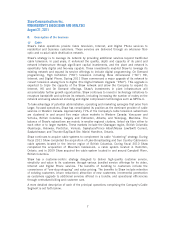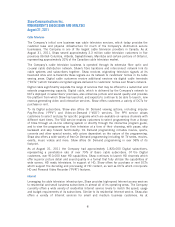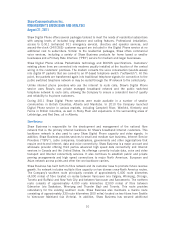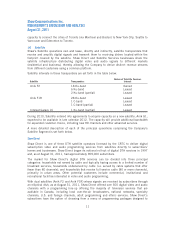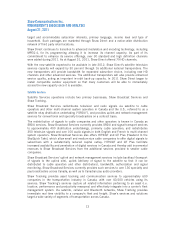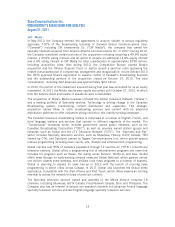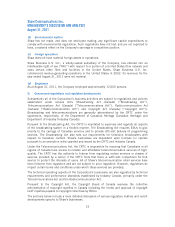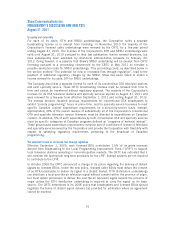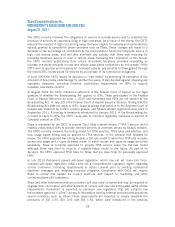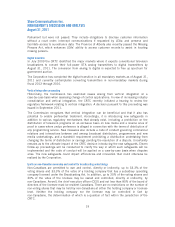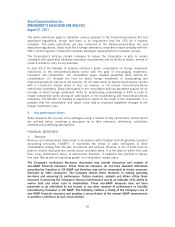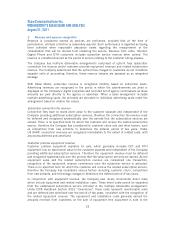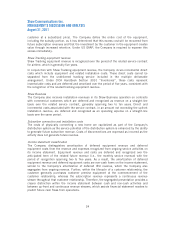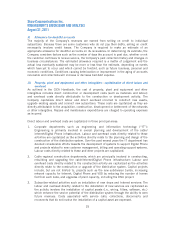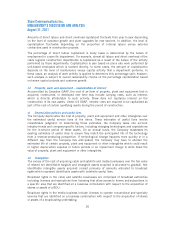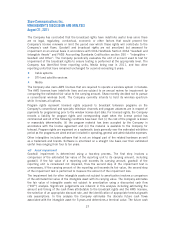Shaw 2011 Annual Report Download - page 21
Download and view the complete annual report
Please find page 21 of the 2011 Shaw annual report below. You can navigate through the pages in the report by either clicking on the pages listed below, or by using the keyword search tool below to find specific information within the annual report.Shaw Communications Inc.
MANAGEMENT’S DISCUSSION AND ANALYSIS
August 31, 2011
In May 2011 the CRTC released its new DTH satellite distribution policy, pursuant to which it
will require Shaw Direct to distribute, in standard definition, all conventional OTA stations that
conform with LPIF eligibility requirements by January 1, 2013. The CRTC did not introduce any
specific rules with respect to the permitted scope of distribution of local stations or any new
rights of remuneration.
In March 2010 the CRTC introduced a new regime to allow privately-owned local television
stations to negotiate a value for the distribution of their programming with cable and satellite
companies. The CRTC is uncertain as to its authority to implement this regime and sought
clarification of its jurisdiction to do so under the Broadcasting Act by reference of the matter to
the Federal Court of Appeal. In February 2011 the Federal Court of Appeal ruled, by a 2-1
majority, that the CRTC has the required jurisdiction. Major broadcast distribution companies,
including the Corporation, have been granted leave to appeal the Federal Court of Appeal’s
decision to the Supreme Court of Canada. Depending on the outcome of the appeal, it is
possible that a negotiated monetary and/or non-monetary compensation regime could arise.
Finally, the CRTC proceeding considering the exemption of SRDU services from licensing, noted
above, also proposes to extend CRTC oversight to the business of satellite uplink and transport
of pay and specialty television programming services by way of the same SRDU exemption
order. Historically, the CRTC’s oversight of SRDU undertakings related only to their distribution
of OTA television and radio stations. The Commission’s proposed exemption order, published for
public comment, includes a condition requiring an exempt SRDU to continue contributing 5%
of its revenue, now defined to also include revenue from the uplink and transport of pay and
specialty services, to support Canadian programming. If the CRTC proceeds to introduce the
proposed exemption order, new regulatory fees or charges could be imposed upon this business.
Access rights
Shaw’s cable systems require access to support structures, such as poles, strand and conduits
of telecommunication carriers and electric utilities, in order to deploy cable facilities. Under the
Telecommunications Act the CRTC has jurisdiction over support structures of
telecommunication carriers, including rates for third party use. In December 2010 the CRTC
issued Telecom Decision 2010-900, significantly increasing the rates (including a retroactive
component dating back to July 2009) for licensees, such as the Corporation, to attach their
facilities to support structures of incumbent telecom carriers. Cable carriers, including the
Corporation, applied to the Commission requesting a review and variance of the decision, but
the application was denied.
Digital Phone, New Media and Internet
Regulation of the incumbent local exchange carriers (“ILECs”), competitors of Shaw’s Digital
Phone business, is now largely governed by the current Government’s deregulatory initiatives.
Specifically, in December 2006, the Governor in Council directed the CRTC to “rely on market
forces to the maximum extent feasible as the means of achieving the telecommunications
policy objectives, and when relying on regulation to use measures that are efficient and
proportionate to their purpose and that interfere with the operations of competitive market
forces to the minimum extent necessary to meet the policy objectives”. Over the past several
years this has resulted in numerous forbearance orders being granted to TELUS Corporation
(“TELUS”), Manitoba Telecom Services Inc. (“MTS”), BCE Inc. and/or Bell Canada (collectively
“Bell”), and SaskTel that cover the majority of Shaw’s operating territory.
17


